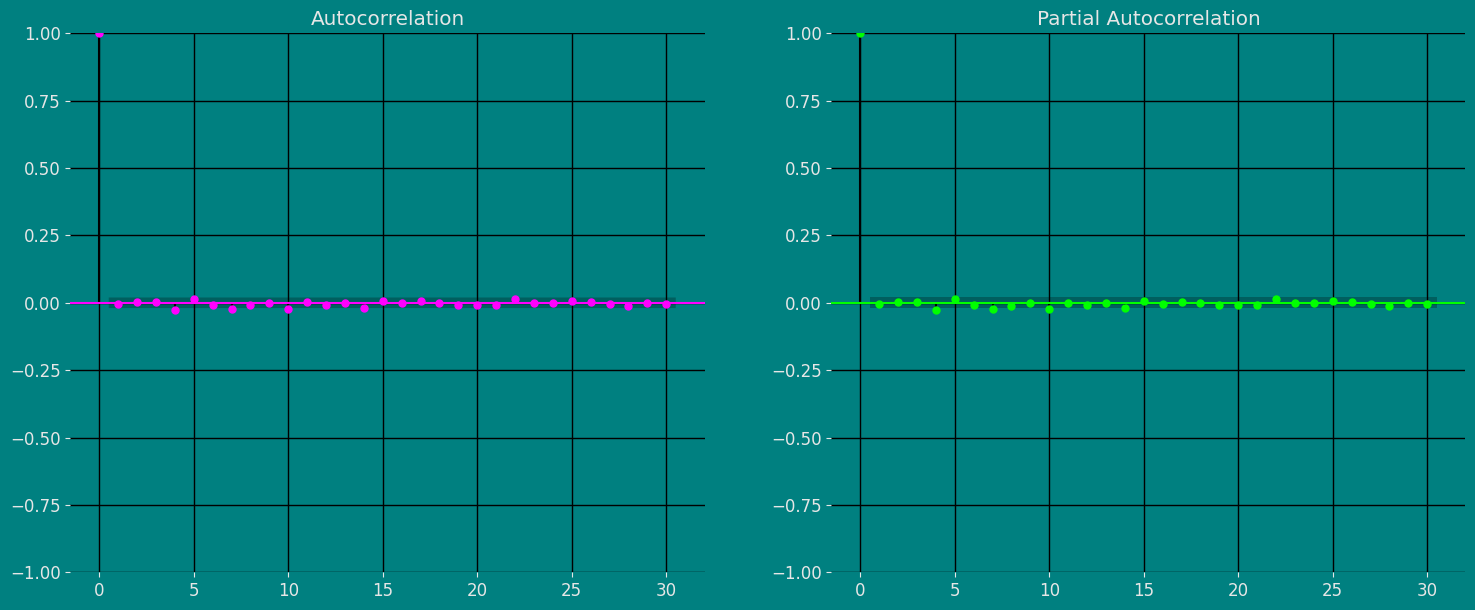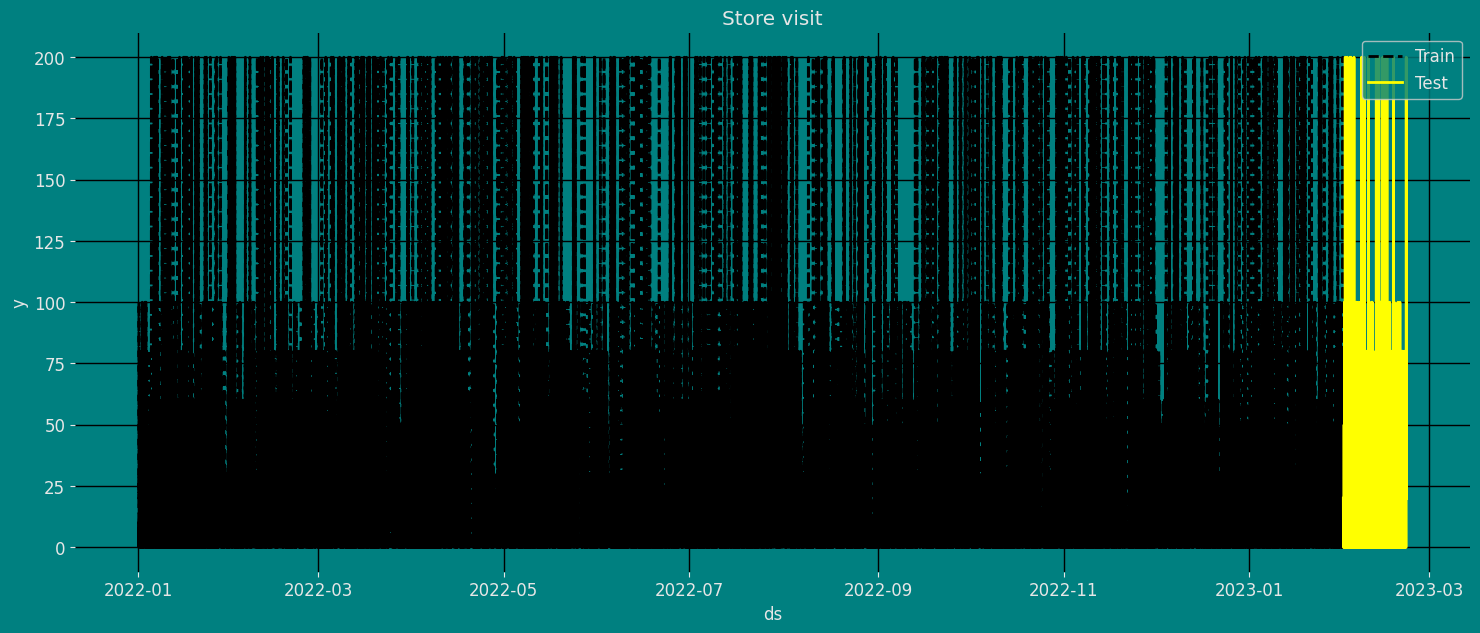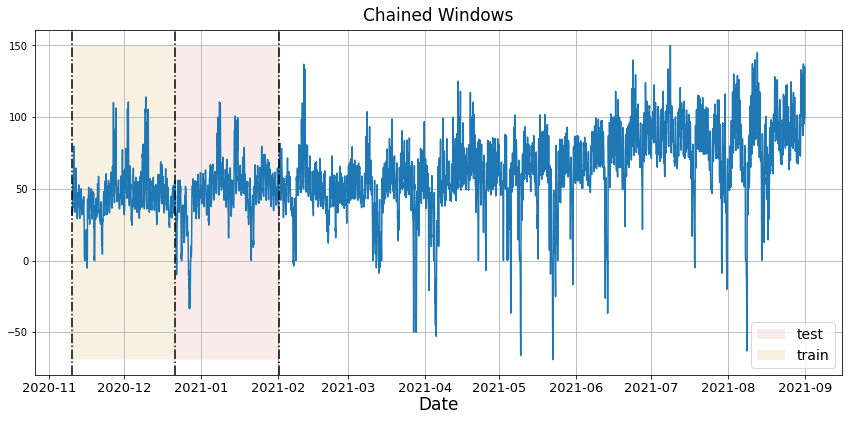Step-by-step guide on using theDuring this walkthrough, we will become familiar with the mainCrostonClassic ModelwithStatsforecast.
StatsForecast class and some relevant methods such as
StatsForecast.plot, StatsForecast.forecast and
StatsForecast.cross_validation in other.
The text in this article is largely taken from: 1. Changquan Huang •
Alla Petukhina. Springer series (2022). Applied Time Series Analysis and
Forecasting with
Python. 2.
Ivan Svetunkov. Forecasting and Analytics with the Augmented Dynamic
Adaptive Model (ADAM) 3. James D.
Hamilton. Time Series Analysis Princeton University Press, Princeton,
New Jersey, 1st Edition,
1994.
4. Rob J. Hyndman and George Athanasopoulos (2018). “Forecasting
Principles and Practice (3rd ed)”.
Table of Contents
- Introduction
- Croston Classic Model
- Loading libraries and data
- Explore data with the plot method
- Split the data into training and testing
- Implementation of CrostonClassic with StatsForecast
- Cross-validation
- Model evaluation
- References
Introduction
The Croston model is a method used in time series analysis to forecast demand in situations where there are intermittent data or frequent zeros. It was developed by J.D. Croston in 1972 and is especially useful in industries such as inventory management, retail sales, and demand forecasting for products with low sales frequency. The Croston model is based on two main components:- Intermittent Demand Rate: Calculates the demand rate for periods in which sales or events occur, ignoring periods without sales. This rate is used to estimate the probability that a claim will occur in the future.
- Demand Interval: Calculates the time interval between sales or events occurring, again ignoring non-sales periods. This interval is used to estimate the probability that a demand will occur in the next period.
Croston Classic Model
What is intermittent demand?
Intermittent demand is a demand pattern characterized by the irregular and sporadic occurrence of events or sales. In other words, it refers to situations in which the demand for a product or service occurs intermittently, with periods of time in which there are no sales or significant events. Intermittent demand differs from constant or regular demand, where sales occur in a predictable and consistent manner over time. In contrast, in intermittent demand, periods without sales may be long and there may not be a regular sequence of events. This type of demand can occur in different industries and contexts, such as low consumption products, seasonal products, high variability products, products with short life cycles, or in situations where demand depends on specific events or external factors. Intermittent demand can pose challenges in forecasting and inventory management, as it is difficult to predict when sales will occur and in what quantity. Methods like the Croston model, which I mentioned earlier, are used to address intermittent demand and generate more accurate and appropriate forecasts for this type of demand pattern.Problem with intermittent demand
Intermittent demand can present various challenges and issues in inventory management and demand forecasting. Some of the common problems associated with intermittent demand are as follows:- Unpredictable variability: Intermittent demand can have unpredictable variability, making planning and forecasting difficult. Demand patterns can be irregular and fluctuate dramatically between periods with sales and periods without sales.
- Low frequency of sales: Intermittent demand is characterized by long periods without sales. This can lead to inventory management difficulties, as it is necessary to hold enough stock to meet demand when it occurs, while avoiding excess inventory during non-sales periods.
- Forecast error: Forecasting intermittent demand can be more difficult to pin down than constant demand. Traditional forecast models may not be adequate to capture the variability and lack of patterns in intermittent demand, which can lead to significant errors in estimates of future demand.
- Impact on the supply chain: Intermittent demand can affect the efficiency of the supply chain and create difficulties in production planning, supplier management and logistics. Lead times and inventory levels must be adjusted to meet unpredictable demand.
- Operating costs: Managing inventory in situations of intermittent demand can increase operating costs. Maintaining adequate inventory during non-sales periods and managing stock levels may require additional investments in storage and logistics.
Croston’s method(CR)
Croston’s method(CR) is a classic method that specifically dealing with intermittent demand, it was developed base upon the Simple Exponential Smoothing method. When Croston dealing with the intermittent demand, he found out that by using the SES, the level of forecasting in each period’s demand are normally higher than it’s actual value, which lead to a very low accuracy. After a period of times of research, he came out a method that optimize the result of the intermittent demand forecasting. This method basically decompose the intermittent demand into two parts: the size of non-zero demand and the time interval of those demand occurred, and then apply the simple exponential smoothing on both part. Where the formula is follow: if then: Otherwise where And finally by combining these forecasts Where- Average demand per period.
- Actual demand at period .
- Time between two positive demand.
- Demand size forecast for next period.
- Forecast of demand interval.
- Smoothing constant.
- The non-zero demand are independent and obey normal distribution;
- The demand intervals are independent and obey geometric distribution;
- There are mutual independence between the demand size and demand intervals.
Croston’s variations
Croston’s method is the main model used in demand forecasting area, most of the works are based upon this model. However, in 2001 Syntetos and Boylan proposed that Croston’s method is no a unbiased method, while some empirical evidence also showed that the losses in performance which use the Croston’s method (Sani and Kingsman, 1997). Plenty of further research is done in improving the Croston’s method. Syntetos and Boylan (2005) proposed an approximate unbiased procedure that provide less variance in the result of estimate, which is known as SBA (Syntetos and Boylan Approximate). Recently, Teunter et al. (2011) also proposed a intermittent forecasting method that can deal with obsolescence, which is based on Croston’s method known as TSB method (Teunter, Syntetos and Babai).Area of application of the Croston method
The Croston method is commonly applied in the field of inventory management and demand forecasting in situations of intermittent demand. Some specific areas where the Croston model can be applied are:- Inventory management: The Croston model is used to forecast demand for products with sporadic or intermittent sales. Helps determine optimal inventory levels and replenishment policies, minimizing inventory costs and ensuring adequate availability to meet intermittent demand.
- Retail sales: In the retail sector, especially in products with low sales frequency or irregular sales, the Croston model can be useful for forecasting demand and optimizing inventory planning in stores or warehouses.
- Demand forecasting: In general, the Croston model is applied in demand forecasting when there is a lack of clear patterns or high variability in the time series. It can be used in various industries, such as the pharmaceutical industry, the automotive industry, the perishable goods industry, and other sectors where intermittent demand is common.
- Supply Chain Planning: The Croston model can be used in supply chain planning and management to improve the accuracy of intermittent demand forecasts. This helps streamline production, inventory management, supplier order scheduling, and other aspects of the supply chain.
Croston Method for Stationary Time Series
No, the time series in the Croston method does not have to be stationary. The Croston method is an effective forecasting method for intermittent time series, even if they are not stationary. However, if the time series is stationary, the Croston method may be more accurate. The Croston method is based on the idea that intermittent time series can be decomposed into two components: a demand component and a time between demands component. The demand component is forecast using a standard time series forecasting method, such as single or double exponential smoothing. The time component between demands is forecast using a probability distribution function, such as a Poisson distribution or a Weibull distribution. The Croston method then combines the forecasts for the two components to obtain a total demand forecast for the next period. If the time series is stationary, the two components of the time series will be stationary as well. This means that the Croston method will be able to forecast the two components more accurately. However, even if the time series is not stationary, the Croston method can still be an effective forecasting method. The Croston method is a robust method that can handle time series with irregular demand patterns. If you are using the Croston method to forecast an intermittent time series that is not stationary, it is important to choose a standard time series forecast method that is effective for nonstationary time series. Double exponential smoothing is an effective forecasting method for non-stationary time series.Loading libraries and data
Tip Statsforecast will be needed. To install, see instructions.Next, we import plotting libraries and configure the plotting style.
| date | sales | |
|---|---|---|
| 0 | 2022-01-01 00:00:00 | 0 |
| 1 | 2022-01-01 01:00:00 | 10 |
| 2 | 2022-01-01 02:00:00 | 0 |
| 3 | 2022-01-01 03:00:00 | 0 |
| 4 | 2022-01-01 04:00:00 | 100 |
-
The
unique_id(string, int or category) represents an identifier for the series. -
The
ds(datestamp) column should be of a format expected by Pandas, ideally YYYY-MM-DD for a date or YYYY-MM-DD HH:MM:SS for a timestamp. -
The
y(numeric) represents the measurement we wish to forecast.
| ds | y | unique_id | |
|---|---|---|---|
| 0 | 2022-01-01 00:00:00 | 0 | 1 |
| 1 | 2022-01-01 01:00:00 | 10 | 1 |
| 2 | 2022-01-01 02:00:00 | 0 | 1 |
| 3 | 2022-01-01 03:00:00 | 0 | 1 |
| 4 | 2022-01-01 04:00:00 | 100 | 1 |
(ds) is in an object format, we need
to convert to a date format
Explore Data with the plot method
Plot some series using the plot method from the StatsForecast class. This method prints a random series from the dataset and is useful for basic EDA.
Autocorrelation plots

Decomposition of the time series
How to decompose a time series and why? In time series analysis to forecast new values, it is very important to know past data. More formally, we can say that it is very important to know the patterns that values follow over time. There can be many reasons that cause our forecast values to fall in the wrong direction. Basically, a time series consists of four components. The variation of those components causes the change in the pattern of the time series. These components are:- Level: This is the primary value that averages over time.
- Trend: The trend is the value that causes increasing or decreasing patterns in a time series.
- Seasonality: This is a cyclical event that occurs in a time series for a short time and causes short-term increasing or decreasing patterns in a time series.
- Residual/Noise: These are the random variations in the time series.
Additive time series
If the components of the time series are added to make the time series. Then the time series is called the additive time series. By visualization, we can say that the time series is additive if the increasing or decreasing pattern of the time series is similar throughout the series. The mathematical function of any additive time series can be represented by:Multiplicative time series
If the components of the time series are multiplicative together, then the time series is called a multiplicative time series. For visualization, if the time series is having exponential growth or decline with time, then the time series can be considered as the multiplicative time series. The mathematical function of the multiplicative time series can be represented as.
Split the data into training and testing
Let’s divide our data into sets- Data to train our
Croston Classic Model. - Data to test our model

Implementation of CrostonClassic with StatsForecast
To also know more about the parameters of the functions of theCrostonClassic Model, they are listed below. For more information,
visit the documentation
Load libraries
Instantiating Model
Import and instantiate the models. Setting the argument is sometimes tricky. This article on Seasonal periods by the master, Rob Hyndmann, can be useful forseason_length.
-
freq:a string indicating the frequency of the data. (See pandas’ available frequencies.) -
n_jobs:n_jobs: int, number of jobs used in the parallel processing, use -1 for all cores. -
fallback_model:a model to be used if a model fails.
Fit the Model
Croston Classic Model. We can observe it
with the following instruction:
Forecast Method
If you want to gain speed in productive settings where you have multiple series or models we recommend using theStatsForecast.forecast method
instead of .fit and .predict.
The main difference is that the .forecast doest not store the fitted
values and is highly scalable in distributed environments.
The forecast method takes two arguments: forecasts next h (horizon)
and level.
h (int):represents the forecast h steps into the future. In this case, 25 week ahead.
| unique_id | ds | CrostonClassic | |
|---|---|---|---|
| 0 | 1 | 2023-01-31 20:00:00 | 27.418417 |
| 1 | 1 | 2023-01-31 21:00:00 | 27.418417 |
| 2 | 1 | 2023-01-31 22:00:00 | 27.418417 |
| … | … | … | … |
| 497 | 1 | 2023-02-21 13:00:00 | 27.418417 |
| 498 | 1 | 2023-02-21 14:00:00 | 27.418417 |
| 499 | 1 | 2023-02-21 15:00:00 | 27.418417 |

Predict method with confidence interval
To generate forecasts use the predict method. The predict method takes two arguments: forecasts the nexth (for
horizon) and level.
h (int):represents the forecast h steps into the future. In this case, 500 hours ahead.
| unique_id | ds | CrostonClassic | |
|---|---|---|---|
| 0 | 1 | 2023-01-31 20:00:00 | 27.418417 |
| 1 | 1 | 2023-01-31 21:00:00 | 27.418417 |
| 2 | 1 | 2023-01-31 22:00:00 | 27.418417 |
| … | … | … | … |
| 497 | 1 | 2023-02-21 13:00:00 | 27.418417 |
| 498 | 1 | 2023-02-21 14:00:00 | 27.418417 |
| 499 | 1 | 2023-02-21 15:00:00 | 27.418417 |
Cross-validation
In previous steps, we’ve taken our historical data to predict the future. However, to asses its accuracy we would also like to know how the model would have performed in the past. To assess the accuracy and robustness of your models on your data perform Cross-Validation. With time series data, Cross Validation is done by defining a sliding window across the historical data and predicting the period following it. This form of cross-validation allows us to arrive at a better estimation of our model’s predictive abilities across a wider range of temporal instances while also keeping the data in the training set contiguous as is required by our models. The following graph depicts such a Cross Validation Strategy:
Perform time series cross-validation
Cross-validation of time series models is considered a best practice but most implementations are very slow. The statsforecast library implements cross-validation as a distributed operation, making the process less time-consuming to perform. If you have big datasets you can also perform Cross Validation in a distributed cluster using Ray, Dask or Spark. In this case, we want to evaluate the performance of each model for the last 5 months(n_windows=), forecasting every second hour
(step_size=50). Depending on your computer, this step should take
around 1 min.
The cross_validation method from the StatsForecast class takes the
following arguments.
-
df:training data frame -
h (int):represents steps into the future that are being forecasted. In this case, 500 hours ahead. -
step_size (int):step size between each window. In other words: how often do you want to run the forecasting processes. -
n_windows(int):number of windows used for cross validation. In other words: what number of forecasting processes in the past do you want to evaluate.
unique_id:series identifier.ds:datestamp or temporal indexcutoff:the last datestamp or temporal index for then_windows.y:true valuemodel:columns with the model’s name and fitted value.
| unique_id | ds | cutoff | y | CrostonClassic | |
|---|---|---|---|---|---|
| 0 | 1 | 2023-01-23 12:00:00 | 2023-01-23 11:00:00 | 0.0 | 23.655830 |
| 1 | 1 | 2023-01-23 13:00:00 | 2023-01-23 11:00:00 | 0.0 | 23.655830 |
| 2 | 1 | 2023-01-23 14:00:00 | 2023-01-23 11:00:00 | 0.0 | 23.655830 |
| … | … | … | … | … | … |
| 2497 | 1 | 2023-02-21 13:00:00 | 2023-01-31 19:00:00 | 60.0 | 27.418417 |
| 2498 | 1 | 2023-02-21 14:00:00 | 2023-01-31 19:00:00 | 20.0 | 27.418417 |
| 2499 | 1 | 2023-02-21 15:00:00 | 2023-01-31 19:00:00 | 20.0 | 27.418417 |
Model Evaluation
Now we are going to evaluate our model with the results of the predictions, we will use different types of metrics MAE, MAPE, MASE, RMSE, SMAPE to evaluate the accuracy.| unique_id | metric | CrostonClassic | |
|---|---|---|---|
| 0 | 1 | mae | 33.704756 |
| 1 | 1 | mape | 0.632593 |
| 2 | 1 | mase | 0.804074 |
| 3 | 1 | rmse | 45.262709 |
| 4 | 1 | smape | 0.767960 |
References
- Changquan Huang • Alla Petukhina. Springer series (2022). Applied Time Series Analysis and Forecasting with Python.
- Ivan Svetunkov. Forecasting and Analytics with the Augmented Dynamic Adaptive Model (ADAM)
- James D. Hamilton. Time Series Analysis Princeton University Press, Princeton, New Jersey, 1st Edition, 1994.
- Nixtla CrostonClassic API
- Pandas available frequencies.
- Rob J. Hyndman and George Athanasopoulos (2018). “Forecasting Principles and Practice (3rd ed)”.
- Seasonal periods- Rob J Hyndman.

